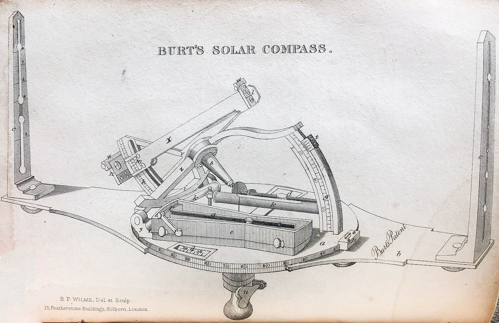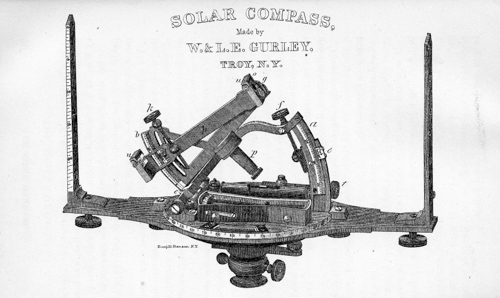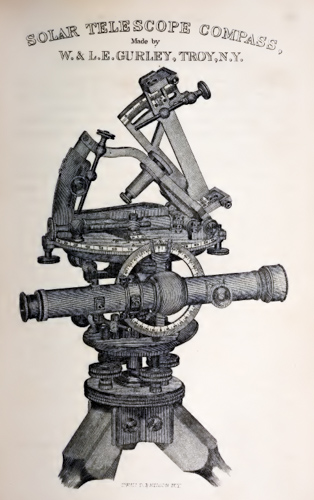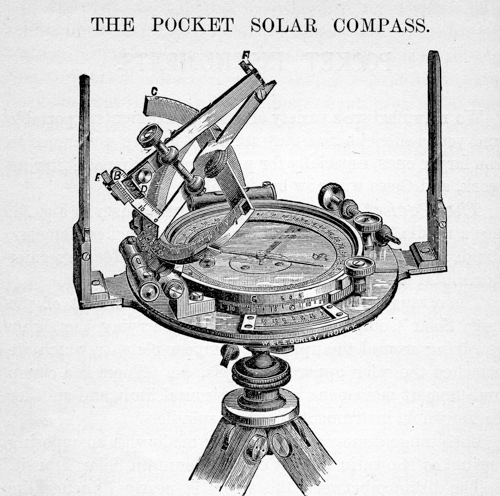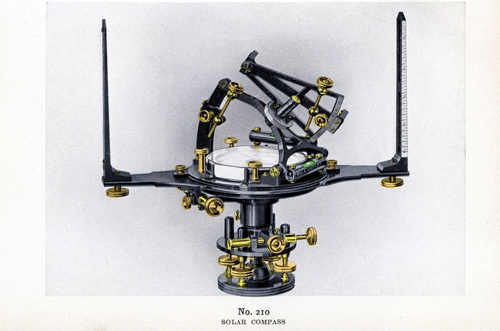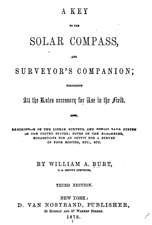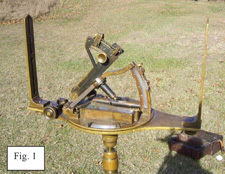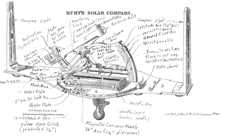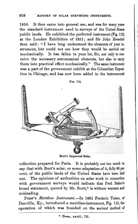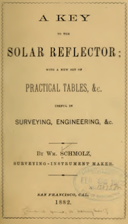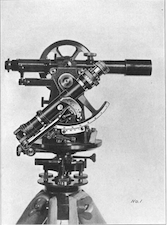eReference Library

Kimball Webster authored a book ("The Gold Seekers of ’49), which was published in 1917. The pic above is the frontispiece, with the pic likely dating in the early 1850s. Webster came to CA as a young man in 1849 for gold of course, and ended up going to Oregon in 1851 for a few years to work as a deputy surveyor. Most of the book is about the CA gold rush years, but he does have 40 plus pages on what life was like as a surveyor in Oregon in the early 1850s. (Kimball purchased his Young Solar Compass in Oregon in 1852 for $350). A pretty interesting read actually.
Young only built approximately 30 solar compass thru 1852, so this is an incredible pic of a very early Young Solar Compass. Click here to see a slightly larger version of the frontispiece (with the pic flipped horizontally so that the solar compass is not inverted).
You can read the book online bu clicking here: The Gold Seekers of '49. The Oregon surveying chapters start around page 182.
Useful Information - Solar Compasses and Transits
Solar compasses and transits are some of the most valuable and collectible scientific instruments made in America. They played a very important role in the westward development of our country, and are feats of creative genius and engineering prowess. To help the collectors of tomorrow, this webpage provides some background information and resources that will give you a better understanding of and appreciation for these wonderful instruments.
You can also find some helpful information about solar compasses and transits in Bud Uzes' Illustrated Price Guide to Antique Surveying Instruments and Books (published in 1980).
Solar Compasses
Burt’s Solar Compass was the most important surveying instrument ever invented in America. The US rectangular system of surveying adopted in 1785 required accurate North – South lines (meridians) to be run. While the magnetic needle compass could generally yield acceptable results, the magnetic compass could not generate acceptable results in areas containing iron ore as the magnetic needle would point to the direction of the iron ore rather than the magnetic north pole. This was a real problem for the westward expansion of the country – land had to be surveyed before it could be sold. No surveys – no sales.
The inventor of the typewriter, William Austin Burt, solved the problem. Burt was a surveyor, and became motivated to find a workaround to the iron ore – magnetic compass problem as he surveyed under government contracts in the Milwaukee area in 1834 – 1835. With a keen appreciation for astronomy, Burt looked to the sun and stars for the answer. Burt rather quickly figured out he could use the location of the sun to determine the location of true north pole.
Burt thereafter created a device that could determine the location of the sun, and mounted the device on top of a regular magnetic compass made by William Young. This device, called the Variation Compass, was remarkable, and worked as described starting in 1836. Using a Variation Compass, Burt could greatly improve the accuracy of surveys, especially in areas with iron ore. The Variation Compass was a commercial failure, however, with Young only making 11 of the devices from 1836 thru 1841 for Burt. While the Variation Compass could accurately find true north, it couldn’t run east – west lines very efficiently, especially given the cost of the instrument.
Burt and Young exchanged ideas on how to make Burt’s novel approach more usable by surveyors in the field. Burt traveled to Philadelphia in the fall of 1840 to work with Young , and they made the first true solar compass in late 1840. This first solar compass was essentially perfect, and established the form for all solar compasses manufactured from 1840 thru the early part of the 20th century.
Using a Burt solar compass, a surveyor could accurately, quickly, and cheaply complete surveys. After enough surveyors and the Surveyor Generals had seen the value of Burt's invention, Burt’s solar compass quickly became the gold standard for all government public land surveys (basically all the land in the western 2/3’s of the US). As a result, the Burt Solar Compass played a critical role in opening up the Midwest and Western states to development, especially those areas rich in iron ore content. I came across a neat 1883 newspaper-like article discussing William Burt and the invention of the solar compass.
Here is what the Commissioner of the General Land Office said in the 1855 Instructions to the Surveyors General of Public Lands of the United States:
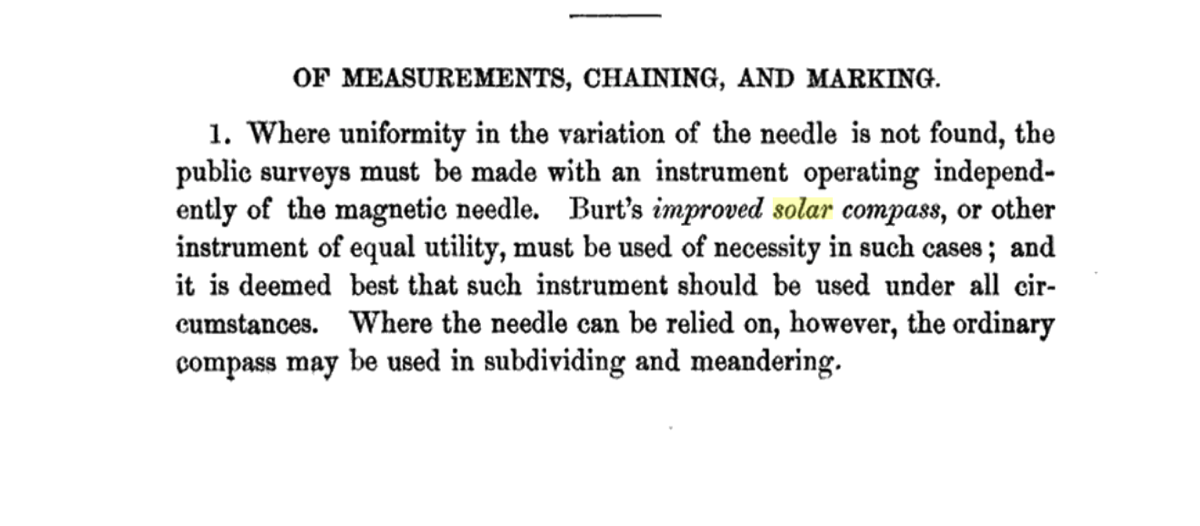
Please see my webpage on Pre-Civil War Young Solar Compasses, which shows some of the evolution of design that occurred during the early years of making Burt Solar Compasses.
More generally, however, here is how the solar compass evolved over its roughly 70 year run:
Burt and Young's first effort - the Variation Compass - built from 1836 to 1841. Basically Burt's solar unit on top of top of a Young compass. While it could find the true North meridian, it was limited in what it could do, and was not commercially viable.
The Solar Compass - Burt and Young nailed it 1840 when the devised and constructed the solar compass. Revolutionized public land surveys. Nearly perfect in form and function, the original form would only change slightly over the next 70 years. The pic to the left shows a Young Solar Compass from the mid 1840s to roughly 1852. A number of instrument makers took a shot at making Solar Compasses in the 1840s and 1850s, and there are some surviving examples. Young was by far the dominant maker in this time period, however.
Scopes were added to the Solar Compasses in the late 1850s, although the design of the solar compasses made it tricky to attached a scope. To the left is a Young Solar Compass with a scope. Opposite the scope is a counter-weight to help keep the solar compass in balance.
The first meaningful tweak to the original solar compass (other than adding a scope) was to add slow movement tangent screws to the latitude and declination arcs (f and k in the pic to the left). This change happened in the late 1850s (Gurley) to the mid 1860s (Young). Many solars made prior to this time were retrofitted with the tangent screws. For this reason, only a handful of instruments are known still in the original form that lack the tangent screws.
Gurley changed the scope setup in the late 1870s. To the left is a Gurley Solar Compass with the new scope set-up. Purchases could buy the scope separately from Gurley, and the scope could work on a regular compass as well.
It was possible to put the Burt Solar unit on a smaller (pocket) compass. I recall seeing somewhere that Gurley sold 75% full size solar compasses and 25% smaller solar compasses. Few of the pocket solar compasses seem to have survived, so they are very collectible. The pic to the left is rom the 1888 Gurley Manual.
Solar Transits
Solar Compasses dominated the public survey market for decades. While adding a scope to a Solar Compass could be a useful feature, Solar Compasses were not really designed to have scopes. A far better option for those who wanted solar ability and a scope would be a solar unit mounted on a transit. A San Francisco maker, William Schmolz, was the first to figure out how to make Burt's solar approach work on a regular transit, and secured a patent in 1867. Schmolz transferred the patent to Gurley, who went right to work on producing solar transits based on Schmolz' design.
Solar Compasses slowly lost marketshare to solar transits over many years. Eventually solar transits became the big seller. Solar transits were far more functional for one thing, as the solar attachment could be removed and the instrument used as a regular transit as well.
In the 1880s and 90s many manufacturers set out to design and make solar transits. Since Schmolz had a patent, the other makers had to develop different ways to accomplish the same result. Many did, which means that there are numerous designs of solar transits existing. A 1901 article went thru the many designs, which is a great reference tool for collectors. The article appears at the bottom of this webpage.

Early Gurley Solar Transit from the 1878 Manual, based on the Schmolz design. Not in the 1871 Catalogue, but is in the 1874 Catalogue. From the Bud Uzes Collection - See Large Pic. The most common solar transit.

Another Gurley Solar Transit, this one with a Jones Patent Latitude Arc, from a 1884 Gurley Manual.

Buff & Berger Transit with a modified Pearsons Solar Attachment, from the 1889 Buff & Berger Catalogue.
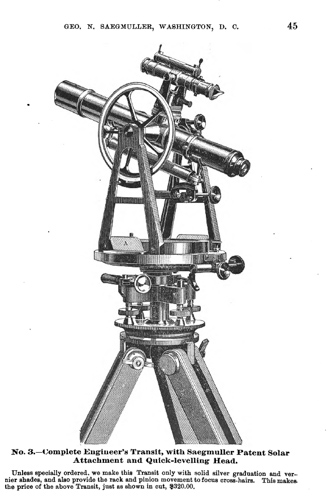
Saegmuller attachment. This transit was made by the Saegmuller instrument firm - see the 1892 Sagemuller Catalogue.

Brandis Solar Attachment - A modified Saegmuller approach - circa 1895. Here are a few pages from the Brandis 1895 Catalogue.
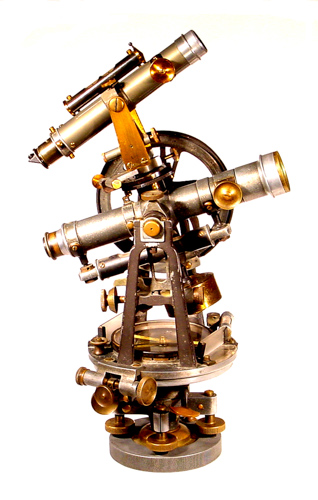
Lietz Aluminum Solar Transit with a Saegmuller attachment, circa 1900. The 1899 Lietz Catalogue. From the Bud Uzes Collection - See Large Pic
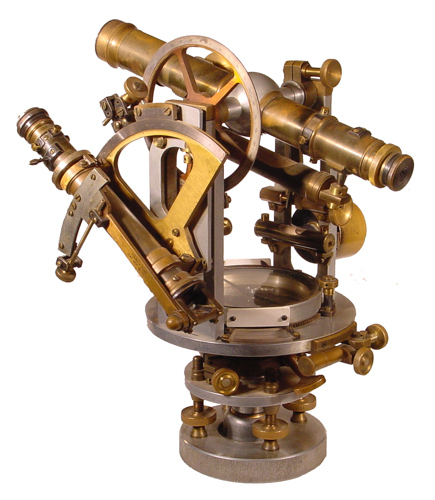
Young Transit with a Smith Solar Attachment. From the Bud Uzes Collection - See Large Pic.
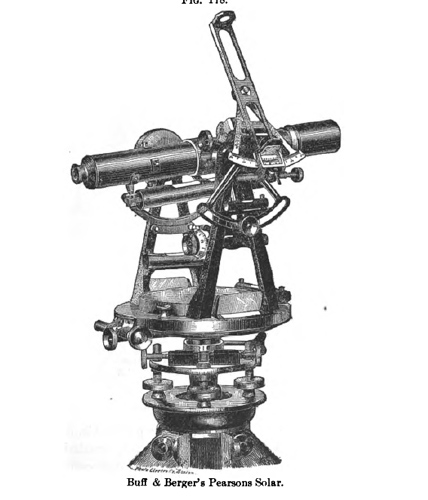
Buff & Berger with a Pearson's Solar Attachment, from the 1884 Buff & Berger Catalogue.
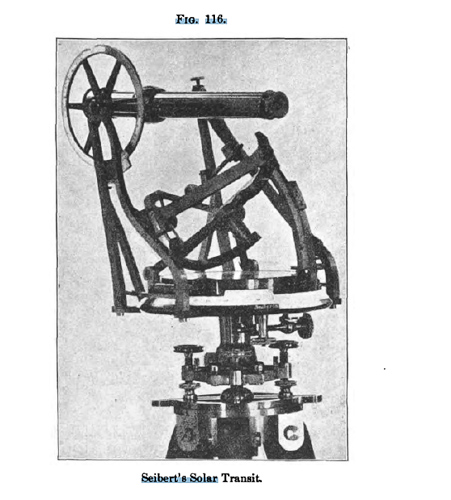
Siebert's Solar Transit
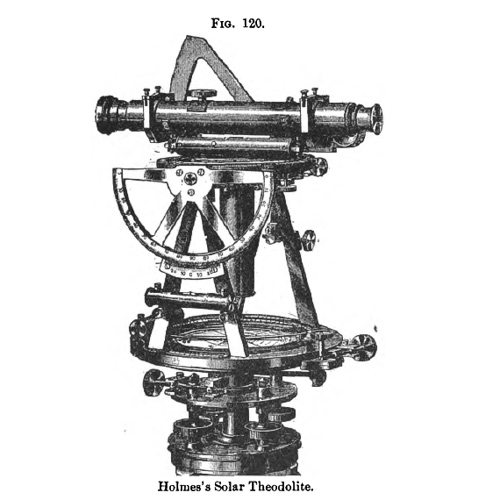
Holmes Solar Theodolite
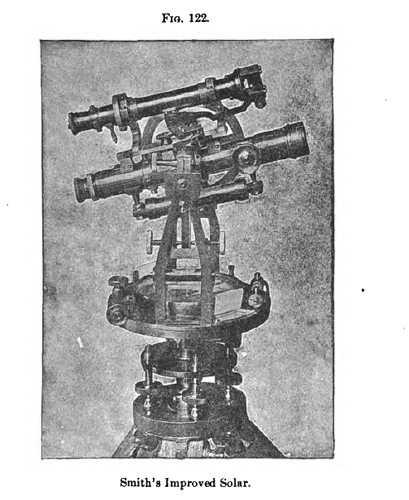
Smith's Improved Solar
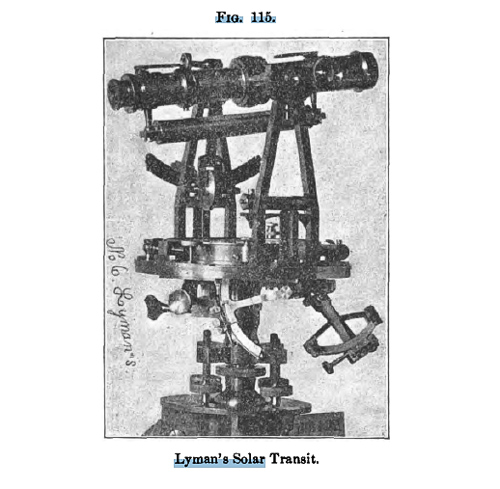
Lymans Solar Transit
Your Solar Instrument Reference Library
Gurley's Instrument Manuals are the great place to find information about Solar Instruments, especially those made after 1860. Here are some other really good resources. Miller's book is a major resource for Solar Compasses made from 1840 thru 1860.
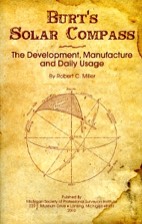
Robert Miller and the Michigan Society of Professional Surveyors Institute published "Burt's Solar Compass - The Development, Manufacture and Daily Usage" in 2011. Miller spent decades researching this book, and it shows. The book comes with a CD that includes all of the materials that Miller used to author the book. A must-have book for solar instrument collectors, and a bargain at only $15. Buy it here (from the Michigan Society of Professional Surveyors).
Using Burt's solar compass was pretty easy, once you knew how. But there was a learning curve. Burt authored books 2 books (the first in 1844 and the second in 1855) on how to use and adjust his solar compass:
1844 - Description of the Solar Compass
1873 - A Key to the Solar Compass (3rd Edition)
1879 - A Key to the Solar Compass (4th Edition)
1881 - A Key to the Solar Compass (5th Edition)
The nomenclature used for solar compasses can be a bit confusing for non-surveyors. Click on the diagram above - a 2 page pdf opens up which names each part of a solar compass. The first page is Burt's original design, the second page shows the improvements made to the first design over time. This pdf is on the CD included with Miller's book.
© 2020 Russ Uzes/Contact Me

